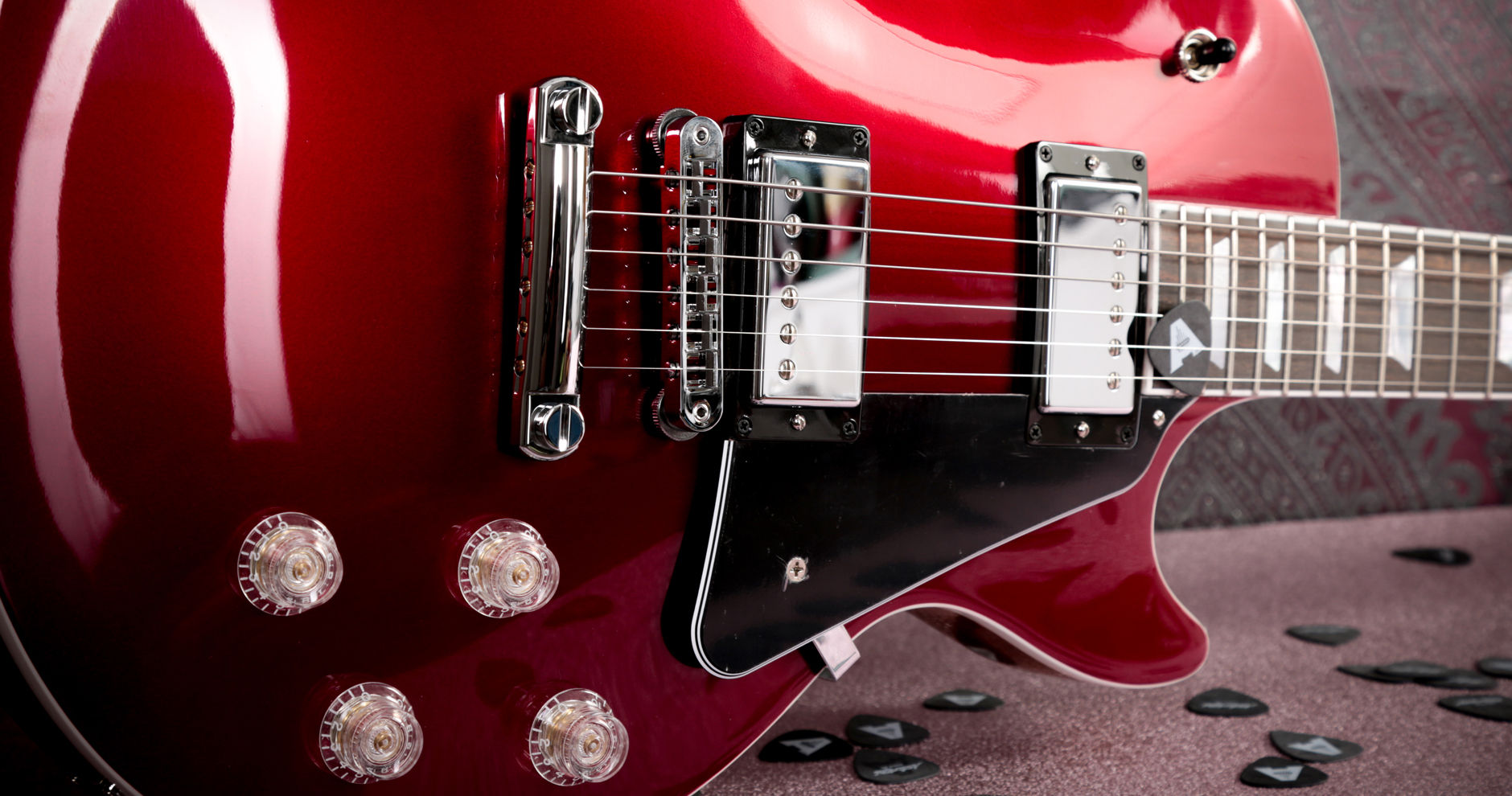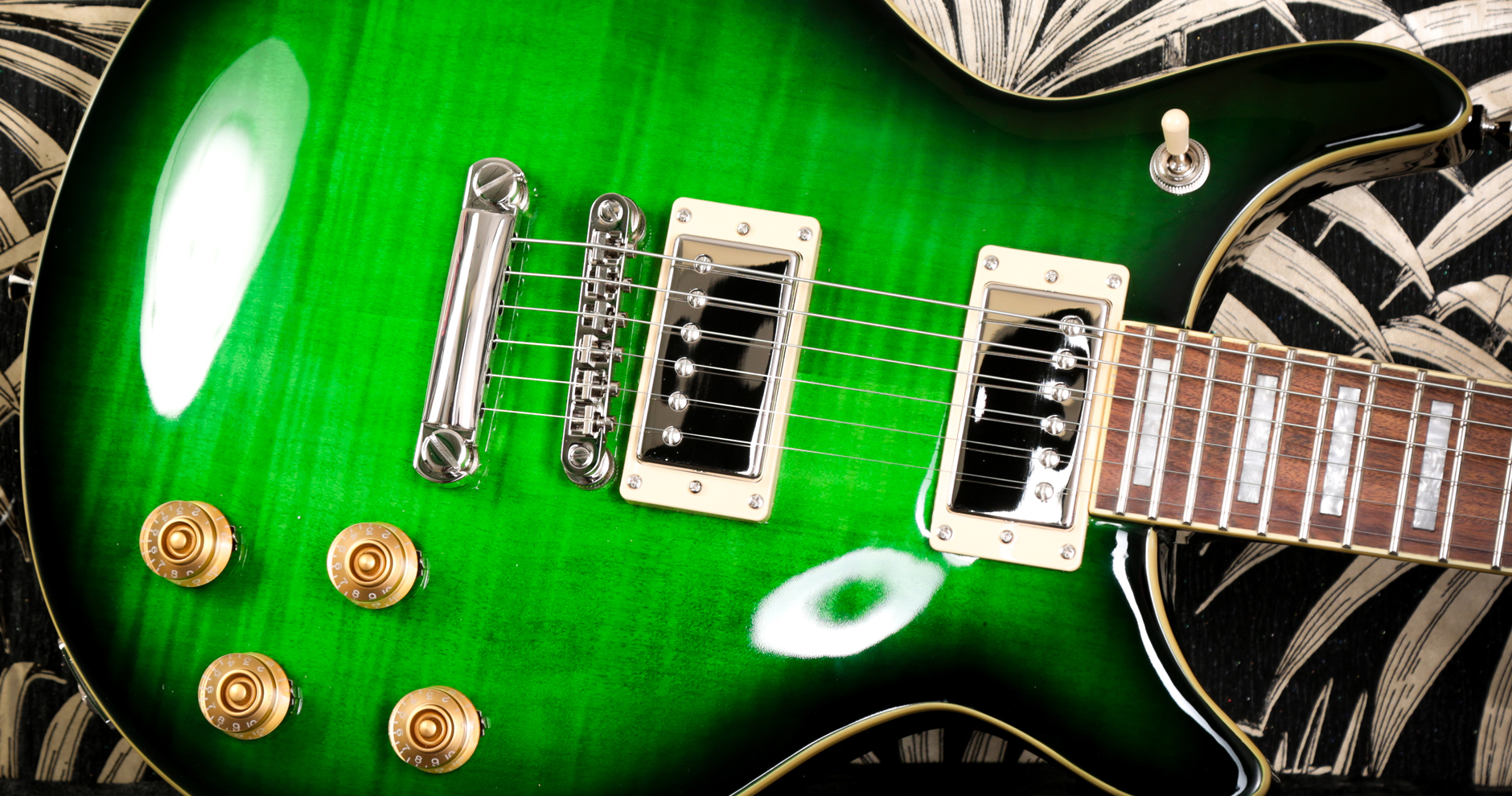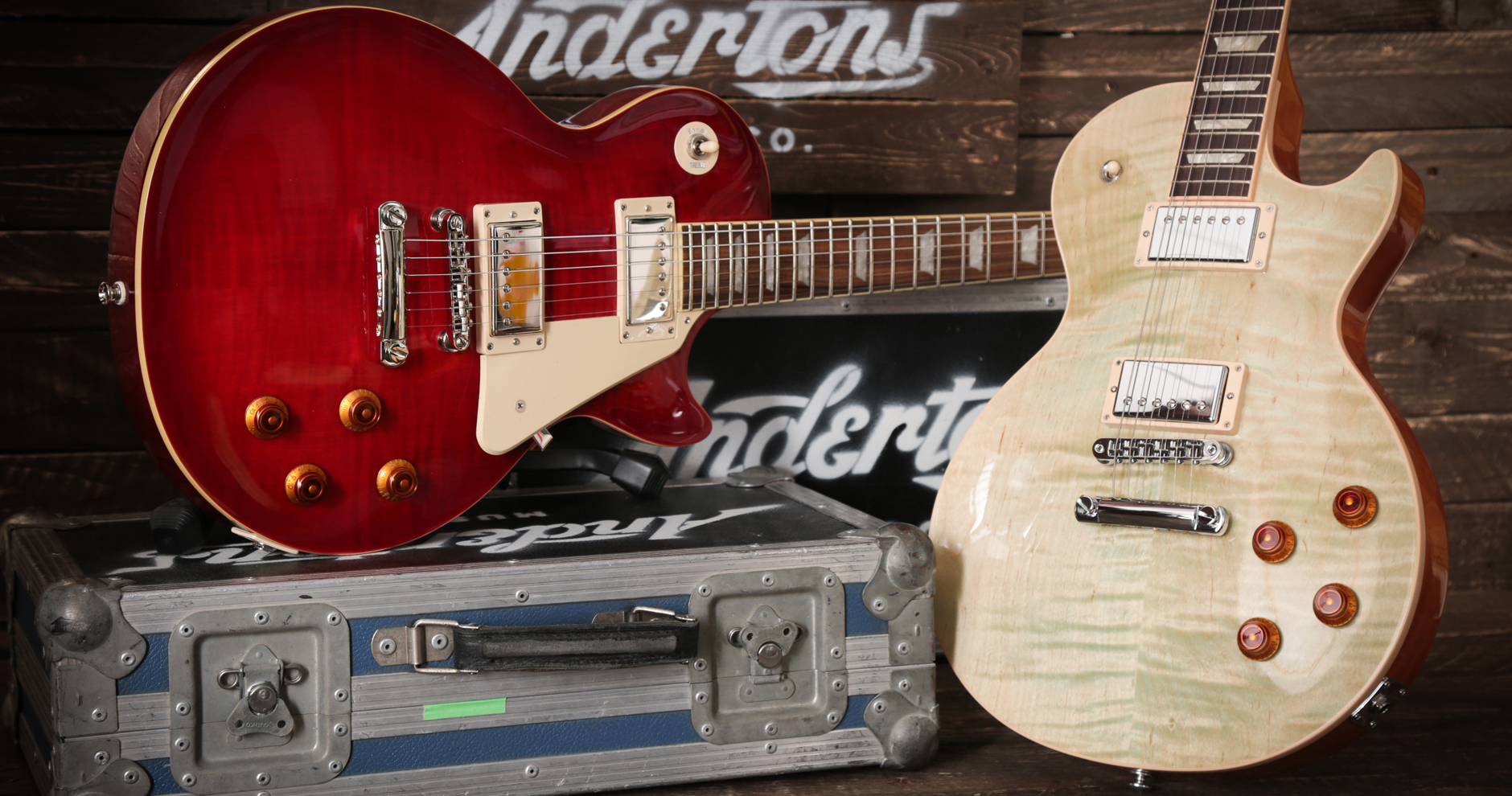- Do Gibson own Epiphone?
- What makes Epiphone a great guitar brand?
- Where are Gibson and Epiphone guitars made?
- Guitar Woods and Finishes
- Guitar pickups
- Body shapes
- Should you buy a Gibson or an Epiphone guitar?
- Want to learn more?
Gibson are one of the greatest pioneering companies of the guitar world. The Nashville-based guitar builders have produced some of the most iconic instruments ever seen in pop, rock, jazz, country, metal music and anything with a guitar-driven backbone. Producing original designs like the Les Paul, SG and Flying V in the 1950s and ’60s, Gibson’s formulas have inspired hundreds of subsequent guitar brands to manufacture their instruments in a similar vein. Every guitarist who has played a Gibson can attest to their quality and longevity. Premium Gibson guitars are expensive and precious instruments that you’ll cherish in your collection. So what are the similarities and differences between Gibson guitars and those of their subsidiary brand, Epiphone?
Do Gibson own Epiphone?
Yes, Gibson does own the guitar brand Epiphone. Founded even earlier than Gibson, Epiphone began making fiddles in Turkey in 1873. They moved to the USA at the turn of the century and began producing mandolins like Gibson at the time. Epiphone was acquired by Gibson in 1957, becoming their “budget brand” following two decades of fierce competition with them in the archtop guitar market.
What makes Epiphone a great guitar brand?
Epiphone have since become far more than a budget option – they have their own styles and uses, and attract many a high-profile guitarist to their ranks of players like Adam Jones, Alex Lifeson, Jared James Nichols, Brendon Small, Nancy Wilson, Tommy Thayer, Joan Jett and Emily Wolfe. Epiphone also make more affordable versions of Gibson’s signature series based on famous guitars that Dave Grohl, Jerry Cantrell, Kirk Hammett, Jimi Hendrix, Joe Bonamassa and B.B. King. They’re stylish, charismatic and attract a new wave of hot musicians that will appeal to many guitarists.
Epiphone build fantastic guitars in their own right, but they are made to occupy a different market to that of their parent company Gibson. You’ll find an array of Epiphone guitars catering to beginners, whilst offering outstanding feature-loaded options through the mid-priced arena up to the top range, which appeal to experienced musicians in search of distinct looks and sounds. Price-wise, most of their Standard ranges end where Gibson’s begin, with a few exceptions like their hollow body USA Collection. To put succinctly, Epiphone make exceptional gigging guitars with gorgeous looks and tones that share ideas with Gibson electrics and acoustics, but liberally apply their own design philosophy to those classic shapes.
Where are Gibson and Epiphone guitars made?

All Gibson guitars are made in the USA and have been since 1894: their solid-body and hollow-body guitars manufactured at their Nashville headquarters, and their acoustic guitars are produced at a separate Montana-based factory. The company’s semi-hollow and hollow-body guitars were previously made in their Memphis factory but Gibson sold the facility in 2018 and moved production to their main Nashville HQ as part of a restructuring process.
Like the majority of the leading brands, many Gibson guitars are made with the assistance of CNC machines. These sophisticated and expensive tools accurately cut bodies and necks out of wood blanks with amazing speed and consistency. Skilled luthiers (guitar builders) then sand, fit and finish every guitar by hand, adding that touch of craftsmanship.
The same processes apply to the more cost-effective production of Epiphone guitars, which have been manufactured in the Chinese-based Qingdao factory since 2004. During the 1980s and ’90s, Epiphones were produced in Korea and Japan by contractors licensed by Gibson. Prior to that, they were produced in a smaller factory next to Gibson’s HQ until 1970.

Guitar Woods and Finishes

Gibson reserves its highest quality woods for its own USA-made guitars competing with the very best premium instruments. Gibson’s signature choice of wood is mahogany. It uses this almost exclusively for its solid-body electric guitar models’ bodies and necks. Maple is frequently used in their construction to form the bodies of many of their hollow-body instruments and as smoothly-carved cap on top of a Les Paul’s body. That quality cut is what gives a Gibson its three-dimensional grain, figure or flame look. Gibson Custom Shop guitars have even more intensely grained maple tops, contributing to their market prices.
A lot of Epiphone’s wood choices derive from those used by Gibson, with mahogany serving as the main material for its solid-body models. This applies to their low-to-medium priced instruments, including the Original Collection and the majority of their Les Paul and SG offerings. To ensure entry-level models remain affordable though, Epiphone employ more easily-sourced alternatives such as poplar. This particular material may not be held in as high regard as mahogany, but most of these guitars will also be lacquered in solid colours, and so the grain will not be visible and the wood plays less of factor in its look.
Fretboard wood
Gibson prefer to use rosewood fingerboards for the vast majority of its instruments. For a short time, they experimented with alternatives such as granadillo and the synthetic Richlite but they quickly returned to the classic for is adored look and feel. High-end Epiphone guitars boast rosewood fretboards just like Gibson. For its more budget-friendly models, Epiphone use pau ferro. Many manufacturers are now using this material, such as Fender, which they incorporate into their Mexican-made guitars.
Maple Veneers
Another way Epiphone achieve a similar look to Gibson guitars with a smaller expense is the use of flamed maple veneers instead of caps on their Les Pauls. A veneer is a thin sheet of wood that is applied carefully over the top of another, which is an art-form that requires lots of skill. However, veneers are far more financially viable as they can use less wood to create a similar look.

Lacquer finishes
All Gibson USA guitars are finished with nitrocellulose lacquer. Many traditionalists prefer the qualities of nitro over polyester and polyurethane finishes, as this plant/solvent-based lacquer was used almost exclusively on guitars from the 1950s and ’60s. Although poly finishes are considered the industry standard today, nitro allows a guitar to age and wear as you see with vintage guitars – the bottom left bout of the body might fade from contact with the forearm, the neck will fade, and the colours will lighten over the years. Nitrocellulose is also more expensive to use as several layers of it must be applied over several days, with the final layer carefully sanded and buffed. This increases labour costs and contributes to the higher price tags on Gibson guitars.
Guitar pickups

Gibson hand-winds their own pickups at the Nashville factory. The brand is synonymous with humbucker pickups, a design Gibson pioneered in the 1950s. Most current models are still fitted with pairs of thick-sounding humbuckers that have shaped the way we enjoy guitar tone. Think of the many genres of music like rock, metal and jazz that are defined by the punch or warmth of a humbucker, or their ability to cancel out the hum and clattering present with a single-coil pickup. Gibson produces the rawer sounding P-90 pickups for its Junior models too that are ever popular in rock and punk and they have experimented with single-coils in the past. Variations aside, Gibson pickups have always been highly-regarded for their broad dynamics and powerful low-to-midrange frequencies. Their versatile BurstBucker pickups have arguably become their most popular, derived from their classic ’50s PAF design and fitted in their flagship Les Paul Standard guitars.
Epiphone guitars come fitted with their own pickups that are wound by machines – although there will be some human involvement when it comes to finishing a guitar pickup because of their intricacies. Their pickups are designed to capture the spirit of those made by Gibson. The Epiphone ‘ProBucker’ is a highly-regarded yet affordable PAF-style humbucker, which was designed in Gibson’s Nashville factory. The P-90 Pro is another noteworthy model, inspired by the sound of the original dynamic P-90s created by Gibson’s legendary pickup designer Seth Lover. Epiphone also fits some of its signature guitars with aftermarket pickups to meet the requirements of their artists, like their use of Seymour Duncan humbuckers in the Adam Jones Les Paul.
Body shapes
You won’t find too many major distinctions between the core Epiphone and Gibson guitar shapes. You’ve got all your key styles in both camps: Les Paul, Les Paul Special and Junior, SG, Firebird, Flying V, Explorer, ES 335, 355 and 339; and with the acoustics, the Hummingbird, J-45, J-200, SJ-200 and L-00. There are however a handful of Epiphone exclusives: the Coronet, Crestwood and Wilshire, and the Casino, Riviera, Sheraton and Emperor Swingster – the former three being solid-bodies and the latter four hollow-body electrics.
The shapes the two brands share don’t differ – only possibly in weight as Gibson tailor that to Studio and Standard ’50s and ’60s models – but there’s a vast range of colours and finishes unique to each brand. For example, the “tiger burst” you would only find with Epiphone and the “transparent ocean blue” you’d only get with Gibson.
Aside from the logos adorned on the headstocks or pickguards, the single key design difference between Epiphone and Gibson comes down to the headstock shape. Both essentially use the shapes they were making before Gibson bought Epiphone. Gibsons typically feature the “open book” shape (it’s pointy at the corners) and Epiphone make the “dove wing” or “clipped ear” shape, which looks a little more pursed in the middle of the design.
Should you buy a Gibson or an Epiphone guitar?
There is a prestige and heritage associated with USA-made Gibson guitars. They represent the pinnacle of craftsmanship for many of us guitarists. As reflected in the price, the level of luthiery is extremely high and they will take time over the fit and finish to make sure you are getting the ultimate instrument. Whether you’re interested in the raw and ready SG Standard or the kitted out SG Supreme, you’re getting a guitar that will play incredibly smoothly, sound insanely good and inspire you every time you play. The real difference between the high- and low-end here are the features such as the hardware and pickups and the aesthetics and finish i.e. the figured maple cap, the inlays and the binding.
The Custom Shop takes things a step further from the Standard range. These are for the collectors; the guitarist who wants era-specific specifications and the best guitars around; and the savvy players who want a guitar that quite often keeps or increases its value.
Gibson has invested a lot of time and money into developing Epiphone over the past 20 years, raising the standard for them to be some of the best guitars from the entry level up to where high-end guitars begin and diminishing returns kick in around £1500. You’ve got a choice to make when you pick your Epiphone: do you go with a classic like a Les Paul Goldtop? One of their Original Collection guitars like the Riviera? Or a top of the range pick like the 1963 Firebird? Anyone bar the players looking for the premium crop of guitars is going to find something they’ll like from Epiphone. Whatever guitar you choose from the line-up, you will get incredible value for money, tons of features and a brilliant visual appeal.
Want to learn more?

Interested in finding out more about music gear and expanding your knowledge? Check out our related articles:




Responses & Questions